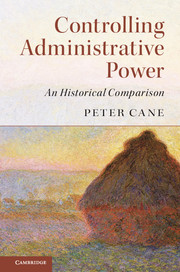Book contents
- Frontmatter
- Dedication
- Contents
- Preface
- Table of cases
- Table of legislation
- 1 Introduction: concepts and methodology
- 2 The English system of government
- 3 The US system of government
- 4 The Australian system of government
- 5 The development and institutional structure of control regimes
- 6 Administrative interpretation
- 7 Administrative fact-finding and policy-making
- 8 Administrative rule-making
- 9 Administrative adjudication
- 10 Private law controls
- 11 Controlling information
- 12 The New PublicManagement
- 13 Controlling the controllers
- 14 Concluding reflections on methodology and themes
- Bibliography
- Index
13 - Controlling the controllers
Published online by Cambridge University Press: 05 March 2016
- Frontmatter
- Dedication
- Contents
- Preface
- Table of cases
- Table of legislation
- 1 Introduction: concepts and methodology
- 2 The English system of government
- 3 The US system of government
- 4 The Australian system of government
- 5 The development and institutional structure of control regimes
- 6 Administrative interpretation
- 7 Administrative fact-finding and policy-making
- 8 Administrative rule-making
- 9 Administrative adjudication
- 10 Private law controls
- 11 Controlling information
- 12 The New PublicManagement
- 13 Controlling the controllers
- 14 Concluding reflections on methodology and themes
- Bibliography
- Index
Summary
Introduction
In some of the most famous passages of The Federalist Papers, James Madison wrote the following:
The accumulation of all powers, legislative, executive, and judiciary, in the same hands, whether of one, a few, or many, and whether hereditary, self-appointed, or elective, may justly be pronounced the very definition of tyranny…[this] does not mean that these departments ought to have no partial agency in, or no control over, the acts of each other [but only]…that where the whole power of one department is exercised by the same hands which possess the whole power of another department, the fundamental principles of a free constitution are subverted…the most difficult task is to provide some practical security for each [department] against the invasion of the others.
Madison here encapsulates one of the fundamental challenges of designing a system of separated powers controlled by checks and balances based on the sharing of those powers: how to prevent checking by the sharer of a power so encroaching on the exercise of that power by its primary repository as effectively to transfer (some of) the power from the repository to the checker. The answer, built into the constitutional design by the Founders, was to provide repositories of power with weapons of ‘self-defence’ against ‘self-aggrandisement’ by those with whom they shared the power. Perhaps the clearest illustration of this technique is provided by the Presidential veto, which gives the President a shield against the power of Congress to initiate legislation without the President's involvement. In turn, Congress can override the veto by a two-thirds majority vote, which may be understood as some sort of guarantee that Congress is not merely seeking to aggrandise a bare majority (one ‘faction’) at the expense of the President (another faction?). Executive privilege, discussed in Chapter 10, provides another example of a Presidential weapon of self-defence in the ongoing contest between the legislature and the executive over access to executive-held information.
The Founders believed that in a ‘republic’ the most dangerous institution in terms of its capacity for self-aggrandisement is the legislature, and that the ‘least dangerous branch’ is the judiciary. Certainly, the Constitution gives Congress much more formal power than it gives either the President or the judiciary.
- Type
- Chapter
- Information
- Controlling Administrative PowerAn Historical Comparison, pp. 475 - 506Publisher: Cambridge University PressPrint publication year: 2016

